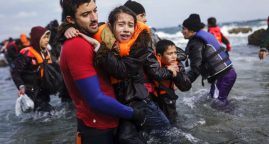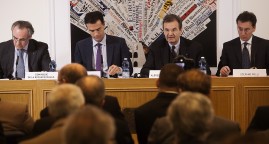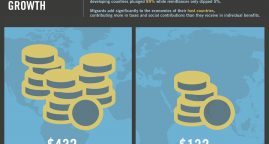EU pays to stop migrants
Article published on Chatham House website on december 2017 by Marissa Quie
Development is no longer the primary aim as aid is used to halt refugee arrivals, argue Marissa Quie and Hameed Hakimi
In 2015, the photograph of Alan Kurdi, the dead three-year-old child lying face down on a Turkish beach, momentarily pricked consciences and silenced the clamour surrounding migrants’ ‘invasion’ of Europe. Almost three years later, the bodies of African girls are regularly retrieved from the Mediterranean, corpses litter the Sahara, and panicked young men sit on planes destined for Kabul, en route to the chaos of war. Unlike Alan, we neither know their names nor care about their stories.
The European response to the migration crisis is to tackle its root causes – poverty, underdevelopment and war – through the instrument of aid. But aid has undergone a profound revolution: no longer centred on development, it has been transformed into a tool to stem what electorates perceive to be a ‘tidal wave’ of migration.
Such reorientation means the uncomfortable realities of migration are outsourced to ‘partner’ nations. Core principles of development cooperation, characterized in the 2011 Busan Declaration as ‘openness, trust, mutual respect and learning’, are damaged. Political expediency undercuts long-term development and ethical donorship, setting disturbing precedents for the future. The European Union’s reputation as the Nobel Prize-winning beacon of human rights is indelibly stained.
The new ‘solution’ legitimizes populist sentiment, giving politicians a narrative on migration to sell to their electorates. The numbers appear encouraging: in Italy, arrivals of migrants by sea dropped from 181,000 in 2016 to 114,000 this year. What is the price of this ‘success’? Smugglers are a recurrent scapegoat for incalculable suffering, but does Europe share the guilt?
More than half of all development aid in the world comes from the European Union, and most aid goes to the least-developed countries. The migration crisis spawned a new ‘results-oriented Partnership Framework’ − the Valletta Action Plan. Partnerships with third countries are structured around tailored ‘compacts’ based on different migration realities, depending on whether the relationship is with a transit country or a country hosting displaced people.
Michael Fallon, the former British defence secretary, said: ‘Well-focused aid should be used to help stabilize countries to prevent conflict breaking out, to discourage mass migrations so that we don’t have to fish people out of the Mediterranean later on’.
When quizzed about the diversion of development funding into a migration agenda, the European Commissioner for International Cooperation and Development, Neven Mimica, responded: ‘Migration goals are development goals’. According to official documents from the European Council, this approach is all about ‘effective incentives’ and ‘adequate conditionality’ for better cooperation on return and readmission.
The 2016 EU–Turkey deal paved the way for a new direction. Leaders agreed to send refugees who had arrived on the Greek islands through irregular channels back to Turkey, and to measures against new asylum seekers. In exchange, European visa requirements for Turkish citizens were liberalized, and the EU provided ‘one in, one out’ financial aid and resettlement programmes for Syrians from Turkey.
The Brussels Agreement on Afghanistan followed. As part of the Valletta Plan, the new Trust Fund for Africa (worth €3.2 billion) was launched, ingeniously blurring development aid with the securitization of migration and reviving postcolonial divide and rule. Through bilateral relationships, the EU essentially forces recipient nations to accept migration-related conditions for aid, which would be rejected if proposed to regional groupings of states.
These changes in EU aid to Tunisia, Libya and Afghanistan illustrate the brutality of reorienting aid to stem migration. Critics think compacts with nations such as Sudan risk legitimizing regimes accused of war crimes and crimes against humanity. Alliances with strongmen and militias in countries such as Libya and Sudan signify an externalization of EU border controls and also potential exacerbation of conflict.
‘Those less fortunate are vulnerable to a slave trade in which they are priced according to their perceived abilities’
Realpolitik has reached a nadir: how should countries that do not cooperate in taking back citizens be addressed? Germany, to take one example, has suggested that aid to these countries simply be cut. Because of its proximity to Italy, Libya – once a magnet for migrants – is now a deadly roadblock.
To understand Libya’s escalating migration crisis, we must recall how its toppled dictator, Muammar Qaddafi, blackmailed Europe with the threat that it ‘could turn into Africa’. In return for European funding, he secured Libya’s 1,100-mile coastline. Today, Boris Johnson, the foreign secretary, more subtly reiterates the demographic threat of African population growth – Niger’s population is predicted to treble over the next three decades, and Nigeria’s to reach 400 million – while many European nations confront fertility crises.
Last year, Viktor Orbán, the Hungarian prime minister, suggested a ‘giant refugee city’ be built in Libya to create a buffer zone, ‘protecting’ Europe from the migrant threat. However, after Qaddafi Libya is too fragile for permanent resettlement.
The International Organization for Migration estimates the total number of migrants in Libya to be about a million, but this figure may be conservative. After failing to intercept fragile boats laden with migrants, European policy-makers now directly intervene through economic investment programmes and support for the Libyan coastguard. ‘Security cooperation’ often takes the shape of tacit deals with powerful militias to reinforce grim detention centres, which Zeid Ra’ad Al Hussein, the UN high commissioner for human rights, brands ‘an outrage to the conscience of humanity’.
In November, UN monitors discovered more than 20,000 migrants packed into filthy hangars who had endured malnutrition, forced labour, violence, torture and rape. Those even less fortunate are vulnerable to a revived slave trade in which they are priced according to their perceived abilities. In response to criticisms of EU policy, Angelino Alfano, Italy’s foreign minister, says the goal is to eradicate smuggling: ‘The most tragic travel agency in the history of mankind.’ Yet, overland smuggling of migrants to Libya continues.
Niger, lying to the south of the Sahara, is the main West African funnel; between 2014 and 2016, an estimated 3,000 migrants arrived weekly in the northern transit centre of Agadez. Niger ranks bottom of the UN Development Index and is one of the world’s most fragile countries, challenged by over-population, food insecurity, and surging religious fundamentalism.
Last year, the EU recognized Niger as one of five ‘priority countries’, and delegations from Germany, Italy and the Netherlands promised €610 million in development aid − contingent on efforts to stem the migrant smuggling trade.
In 2015, Niger criminalized human smuggling. In return, the EU Common Security and Defence Policy provided local security forces with training on migration, equipment and intelligence.Through the IOM, the EU funded three transit centres, supposedly designed to help migrants make ‘better informed migration decisions and to assist in the return of those intercepted’.
In 2016, the EU acknowledged that reduced numbers of migrants in Niger have not resulted in a net reduction in arrivals in Europe. So, what happened? Peter Tinti, a fellow at the Global Initiative against Transnational Organized Crime, says that tightening security actually increases smuggling profits. Riskier routes through the desert at night mean smugglers can raise prices. Crackdowns on transit centres such as Agadez are mostly symbolic – given the omnipresence of corruption, insignificant operatives are targeted, allowing the smuggler kingpins to consolidate power.
Tim Eaton and Paul Melly, two researchers at Chatham House’s MENA and Africa programmes, argue that migrant smuggling is an integral component of the local political economy. Niger’s anti-corruption agency uncovered the symbiosis between state security forces and smuggling: bribes provide cash for essentials, such as food and vehicle spare parts.
Factions within Niger’s coup-prone military are threatened by counter-smuggling policies, and the government may be forced to redirect development, health, and education funding to fill the gap. In towns such as Agadez, migration is a critical source of community income, encompassing everyone from politicians and police to drivers, landlords, and shopkeepers. Kidnapping, terrorism, and war are the repugnant alternatives to profits from smuggling. Lack of income could also lead to sectarian conflict and separatist movements.
Sudan is the locus of migration routes linking East and West Africa to the Mediterranean Sea, Europe, the Gulf States, and southern Africa. It plays host to an estimated 800,000 refugees – the third highest in Africa – and the second-largest population of internally displaced people in Africa, estimated at 3.2 million. Around 4.8 million people in Sudan – including many refugees, asylum seekers, and the internally displaced – are in urgent need of humanitarian assistance.
‘The new European politics of aid shows the increasingly complex practices which govern refugee lives’
Through the new ‘partnership’, the EU has pledged €215 million to Sudan to curb migration. Germany and Italy have signed bilateral agreements to tackle migration and promote repatriation under the umbrella of the EU-Horn of Africa
Migration Route Initiative (the ‘Khartoum Process’).
Meanwhile, Sudan openly uses government-aligned militias to arrest migrants. In August, Italy deported 48 Darfuris to Sudan, despite inadequate protection of their human rights. Similarly, Sudan has deported hundreds of Eritreans.
States such as Sudan, Eritrea, Somalia, Ethiopia and South Sudan − all participants in the Khartoum Process − are responsible for policies that directly give rise to the migrant problem. In this context, EU outsourcing of migration through ‘partnerships’ is counterproductive on all levels.
Afghanistan is another key piece of the EU aid/migration puzzle. In 2016, a total of 183,000 Afghans applied for asylum, making them the largest group of first-time asylum seekers in the EU. Afghanistan remains highly dependent on foreign aid, approximately 40 per cent of its GDP, and two-thirds of its budget is allocated to security. Kabul therefore has little choice but to accept what one Afghan government official calls a ‘poisoned chalice’. The removal of aid is a threat to President Ghani’s fragile administration, and to its ability to maintain the 400,000-strong Afghan national security forces. Without it, the Afghan state is unlikely to survive.
Ghani calls Afghanistan the ‘front line’. The number of internally displaced people has risen to 1.4 million. In 2016, nearly 3,500 civilians died in the war, including almost 1,000 children. Taliban factions, Islamic State and more than a dozen other terrorist groups have gained ground. Three million Afghans live in insurgent-controlled areas, and 20 US-designated terrorist organizations now operate in the borderlands between Afghanistan and Pakistan.
The withdrawal of NATO in 2014 destabilized both security and the economy. The Taliban seized Kunduz province in 2015, and engaged in further attacks the following year as EU representatives justified the programme of repatriation. The peace process has been mired in controversy. In recent months, Ghani has tried to rekindle his predecessor Hamid Karzai’s style of governing: warming up alliances with warlords and appointing dubious characters to high-level roles. Corruption is prevalent and the illicit economy, including the heroin market, generates substantial revenue for the insurgency and criminal networks in Afghanistan.
European officials denied that the repatriation deal was a condition for aid. Federica Mogherini, the EU’s top diplomat, claimed: ‘There is never, never a link between our development aid and whatever we do with migration’. German and Afghan officials were more candid; Frank-Walter Steinmeier, the German president, said that his country’s future aid to Afghanistan was conditional on the government’s ability to accept the return of migrants. The deal made aid and development contingent on repatriation.
Potential ‘returnees’ rarely simply arrive in European airports as asylum seekers; they spend many years in different countries trying to reach target destinations. Many have never actually lived in Afghanistan. Their experiences and the conflict and political fragility in Afghanistan mean ‘re-admission’ will be anything but straightforward. Failure to find a job or reintegrate leaves them vulnerable to recruitment by criminal and terrorist factions. This risk may not only exacerbate the Afghan war but create new terrorist threats to Europe.
According to a 2016 leaked memo from the European External Action Service, EU representatives knew that the Afghan government would interpret making aid ‘migration-sensitive’ as a trump card, which would force compliance.
The memo said the EU was ‘aware of the worsening security situation and threats to which people are exposed’, and recognized Afghanistan was suffering ‘record levels of terrorist attacks and civilian casualties’.
Yet, ‘despite this, more than 80,000 people could potentially need to be returned in the near future’. Salahuddin Rabbani, the Afghan foreign minister, has said that European countries threatened Afghanistan with an impossible choice: ‘Accept our aid for your refugees or your development projects … They told us they cannot support both development projects in Afghanistan and Afghan refugees in EU’.
The new European politics of aid illustrates the increasingly complex practices that govern refugees’ lives. The divisions between security and development are eroded, and aid is repackaged as a weapon to achieve security objectives. The ugly processes of detention and deportation are effectively franchised to governments unable to guarantee international standards. Migrants are faced with insurmountable challenges. In addition to the reasons behind their flight, unsuccessful journeys leave them in debt, psychologically unstable, angry and disappointed. The EU’s new orientation paves the way for protracted aid dependency and will be counterproductive for security in both Europe and the developing world.
Europe is no closer to finding a coherent way of addressing the ‘migration threat’ and achieving security. International asylum law is still burdened with artificial distinctions between refugees and economic migrants. Many migrants straddle these categories, because extreme poverty and lack of opportunity create their own forms of desperation. If aid is diverted to be a weapon against migration, the price will be paid in human rights and development.
Related Articles
Migrant Arrivals to Europe via Mediterranean Top 210,000 in 2016
06/14/16. In other words, fatalities on the Mediterranean Sea in 2016 stand at 1,020 ahead of last year’s mid-year total.
Population fleeing from war: rescue, assistance and integration towards the world humanitarian summit
11/11/2015 . The press conference organised by the Order of Malta: challenges and prospects of the migratory phenomenon
Migrants significantly contribute to economic growth
09/01/2016. In 2015 alone, migrants sent $432 billion back to developing countries.





